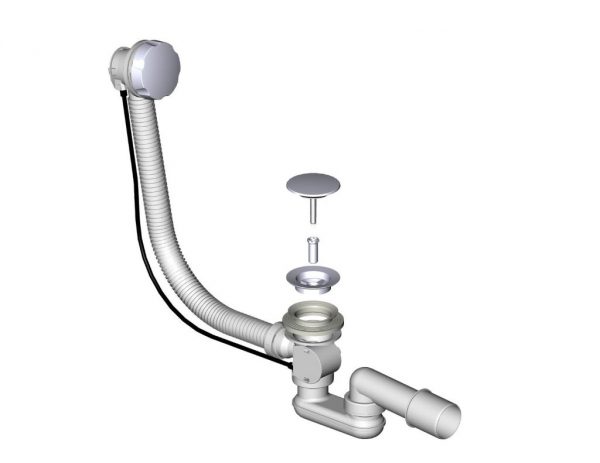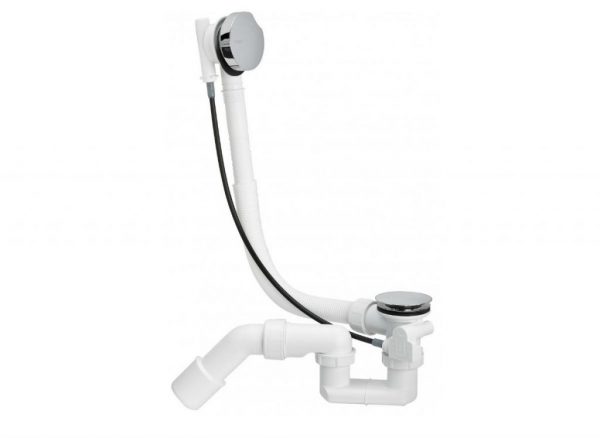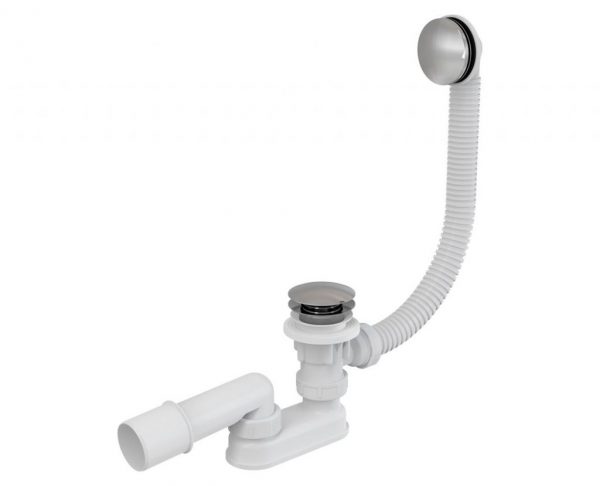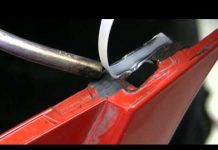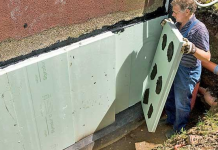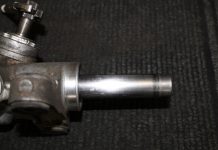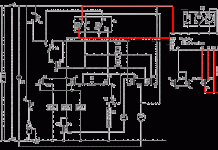The bathroom systems we are interested in can be semi-automatic and automatic. The first type of drain has a small cable. It serves as a connector between the drain plug and the overflow device. Semi-automatic drain is used elementarily. When you need to open its hole, pull the cable and thereby raise the cork. Water from the font rushes into the sewer pipes.
A semi-automatic type drain is inexpensive, it looks quite attractive outwardly, even a child can operate it correctly without any extra effort. The only disadvantage of this design is that the cable that lifts the cork can break with frequent use. However, this problem is inherent in extremely inexpensive mechanisms. Automatic drain is structurally more complex. It functions differently. To lift the cork, you need to click on it. And the automation itself will open the entrance to the drain hole! The mechanism providing this possibility is mounted in the cork itself. The disadvantage of the system is the need to lean towards the bottom of the bath to press the lid.
Recently, another type of automatic drain with a special filling device has been actively used. Its installation is recommended for fonts without a mixer. Such a mechanism connects the water supply pipe to the overflow. This allows you to draw water into the bath through an overflow device. Drain-overflow systems are made of metal and chrome-plated brass, as well as polyethylene and various types of polypropylene. Metal products in operation are short-lived. Now they are practically not used.
Brass, polyethylene and polypropylene systems are ideal for the bathroom. They are not afraid of hard and salty water, do not rust, do not rot with prolonged use.
The most expensive is the brass siphon. He looks great. It is used when they want to create a special interior in the bathroom. But according to some indicators (in particular, in terms of the level of resistance to mechanical stress), brass products are inferior to cheaper and at the same time more resistant polypropylene and plastic structures.
VIDEO
To properly and quickly install the siphon with your own hands, you need to stock up on an ordinary flashlight and a set of screwdrivers. You will also need silicone-based sealant, plastic pipes and 40-50 mm sewer pipes. The replacement of the overflow system begins with the dismantling of the old mechanism and the high-quality cleaning of the sewer pipe (its inner part). If the wiring in the bathroom is made of plastic pipes, you will not have problems with cleaning them.
The situation is more complicated with cast iron tubular products. They are connected to the pipe by means of cement mortar. Breaking it is not so easy. We'll have to arm ourselves with a chisel and a hammer and beat off the cement. Note! Cast iron pipes only look massive. In reality, they are quite fragile. They can be split with too strong and sharp blow of a chisel. Therefore, special care must be taken when cleaning cast iron products.And do not forget to carefully clean the smallest crumbs of the cement mixture from the pipes after disconnecting the pipe. Otherwise, you will be guaranteed a blockage.
Connecting a bathtub drain to a cast iron pipe
Now you can safely mount a new drain in the bath. Carry out the work as follows:
Insert the rubber pad into the bottom overflow, bring it with one hand to the drain hole from below. Apply the top gasket with the second hand, install and fix the product with a screw. First, you can simply bait it, and then tighten it with a screwdriver. It is important not to overdo it here. Polypropylene and polyethylene products may well burst if you tighten the screw too much.
In the same way, the upper neck (overflow) is installed in the bath. Experts recommend directing its nozzle a little to the side, and not strictly down. This is done to facilitate the connection of this element to the drain neck.
Connect the overflow and drain with a corrugated hose. An important point. A long hose must be carefully bent and not shortened. Corrugation without problems bends at any angle. You will not have any difficulties.
Connect the siphon under the bathtub to the overflow neck. And then connect the pipe or corrugated hose to the mounted structure.
Insert through the cuff-seal or directly into the socket of the sewer pipe with a water seal.
Siphon replacement done! It remains only to make sure that you did everything correctly. Close the drain in the font with a cork, fill the tub with water. The absence of a leak when the lid is closed tells us about the quality assembly of the plumbing siphon. Then open the plug and see if there are any leaks in other parts of the system. If everything is fine, feel free to use the bathroom with a new siphon that you installed yourself.
If there is a leak at any of the joints of the mounted mechanism, the system will have to be slightly modified: eliminate the misalignment of the elements of the water lock (most often it occurs when the font is blown with mounting foam); tighten the screws and nuts tightly. After these steps, everything will be fine. Happy steam to you!
The arrangement of a full-fledged room for water procedures hides many subtleties and nuances. We are talking not only about the purchase and installation of faucets, a shower cabin, a water tank, a sink, but also about small structures that are almost invisible from the outside, but perform important functional tasks.
One of these devices is a bathtub overflow.
Drain-overflow takes away the used liquid and prevents overflow of a bowl at uncontrolled water supply. The structure provides two holes - at the bottom and in the wall of the bath. Connected hoses connected to the sewer are brought to them.
On sale there are three options for drain-overflow systems. The difference between them lies in the method of removing the plug that clogs the drain hole. If you are going to buy a bathtub overflow and doubting which one is better to choose, you should pay attention to the model of your bathing tank and its location in the room.
The simplest type of device is determined by the traditional design, found in almost every apartment. It has no moving parts or levers. Water is drawn in when the cork is closed, and descends when it is opened.
Products in this category differ in the type of connection to the sewer, sealing connections, and the shape of the pipe. Devices include the following items:
Drain neck . Installed in a hole made in the bottom. It consists of a chrome-plated funnel that "catches" large particles of debris, and an expanding nozzle with a built-in nut. The parts are joined with a reinforced metal screw. A rubber seal is responsible for the impermeability.Overflow neck . Inserted into the wall of the bath.The design is similar to a drain, but adjoins the general circuit of the network through a lateral, rather than a direct, drainage system.Siphon . Arc-shaped removable pipe designed to act as a water seal. Blocks attempts of unpleasant sewer smells to get into a bathroom. Binds the mechanisms with each other and with the sewer network. Available in various configurations. Models with a deep shutter that can hold at least 300 ml of liquid are considered optimal.Connecting corrugated tube . It diverts water entering the overflow to the siphon. Connects to other accessories with branch pipes.Auxiliary pipe - soft or hard. Provides a drain from the siphon to the sewer pipe.The kit also includes connecting parts that increase the tightness of the system. These are flat and conical gaskets used together with a union nut. The conical products are mounted from the nut with a sharp edge so that the thin part goes inside the opposite element.
The advantages of manual strapping: budget price, the simplest assembly / installation algorithm, rare breakdowns, reliability. Among the shortcomings, it should be noted the rapid wear of the seals.
A later modification of the traditional design is the semi-automatic system. It contains the largest number of components. It is supplemented by a control unit that raises/lowers the plug, a gate valve, and a cable that controls its position.
The system is activated by tightening and loosening an auxiliary cable located inside or outside the overflow pipe. The first option looks more aesthetic, but it is much more difficult to repair.
convenience of closing the drain (without the need to bend over, wet your hands);
comfortable management and operation;
stylish decor.
The disadvantages of the device include a complex structure with a mass of moving and connecting components and the risk of jamming of the cable over time.
In semi-automatic systems, the overflow holes are hidden behind the control unit. Visible details perform a decorative function in the interior due to thoughtful design.
A distinctive feature of automatic systems is a complex structure with a click-clack valve equipped with a latch and a built-in spring.
Buttons are made in elegant high-tech, modern, retro design styles. They are made of brass and copper, coated with chrome or nickel plating.
Benefits of automated fixtures:
ergonomics and presentable appearance;
compactness;
convenient descent of water.
There are also many disadvantages: the high cost of proposals, the vulnerability of the spring holding the valve, the difficulty in replacing the button, painstaking installation, often requiring professional intervention.
The drain automatic machine can be endowed with functionality on a set of water. It is considered if it is impossible to rationally place a mixer in the bathroom.
The scheme includes pipes for the liner, which are connected to the overflow hole. The bowl is filled through the top outlet, which eliminates flooding, as the flow automatically stops when there is an excess of water.
In the production of devices, materials are used that are resistant to corrosion, alkaline and acidic substances, hot water. In the last century, when the range of plumbing equipment was rather narrow, drain systems were made mainly of ferrous metal.
Although this material quickly loses its original aesthetics, it regularly serves for a long time, bravely withstanding high pressure and temperature changes. Despite its advantages, now manufacturers still prefer non-ferrous metals and plastic.
Plastic strapping attract affordable price. They are appropriate in bathtubs equipped with a closing screen. Their universal dimensions adapt to non-standard sewer outlets and drains.
Significantly ahead of plastic in terms of strength, service life and design of metal objects. The most common products are brass, bronze, copper. Drain grilles and certain parts in them are plated with chromium or nickel using electroforming techniques.
Under the condition of timely cleaning of devices with disassembly of washer joints, unlike plastic, they are unlikely to fail even after decades.
You can understand what kind of metal the structure is made of by carefully examining the pipe that fastens the drain and overflow holes.
Copper is recognizable by its reddish hue, plasticity and softness. Brass is a durable yellow alloy of zinc and copper. Bronze is a fairly hard dark brown material that includes copper and tin.
When choosing a device, buyers are guided by personal requirements and wishes. It is no less fundamentally recommended to evaluate the product you like, taking into account other serious criteria. For instance:
Price category . With a small budget, plastic equipment with manual drain is optimal. A more expensive device with automatic / semi-automatic mechanisms is suitable for those who are looking for a solution with an original style and a convenient modern design.Material . The quality indicator of propylene is a dense shell, brass is a perfectly smooth surface, cast iron is the absence of the slightest cracks, since they cannot be repaired.Additional options . Siphons can have several connections for connecting other consumers, in addition to the bath. You can not use them by closing them with a nut. In the future, this thoughtful step will give a chance to save on branching the drain for the sink, washing machine and dishwasher.Diameter matching - at the siphon and sewer pipe. If the sections are incompatible, you need to choose rubber or plastic adapters.Completeness . The kit of any system should include all elements for connection, sealing rings, gaskets for pipes and overflows, excluding leaks.Another criterion, which is far from the last value, is the manufacturer of sanitary fittings. The service life and serviceability of the selected drain-overflow system depends on it.
In order not to get into trouble and not suffer with a problematic product of dubious quality, you should purchase goods from well-known and trusted European companies. They manufacture equipment according to generally accepted international standards and norms.
Geberit . A high-quality Swiss brand with a wide range in medium price terms. The product is easy to use and adapts well to non-standard sizes.
Alcaplast . One of the largest manufacturers of sanitary ware in Eastern and Central Europe. The Czech trademark produces devices with a special design and simple construction that perform their functional tasks stably and silently throughout their entire service life, regardless of the effects of aggressive environment factors.
Kaiser . A manufacturer from Germany that manufactures fittings for modern bathtubs. The company's products allow you to adjust the length of the siphon in a wide range, which makes it easy to install it, including in deep models of bowls.
viega . A German company that has established itself in the market as a manufacturer of safe sanitary products of the highest quality that can last for about half a century. They successfully combine design and engineering ideas.
The range includes drain-overflow systems with different shapes, materials, color variations. They are characterized by a relatively low price and simple installation.
Hansgrohe . Another representative of solid German quality. The company's strappings are reliable, efficient, distinguished by a complex high-tech structure. In interiors, they are valued for their functionality and excellent decorative performance.
Having experience in installing a mechanical type drain in a bathroom, a semi-automatic circuit is not needed - it is almost identical. Even without the skills, you can master it with your own hands, but for starters, it is advisable to familiarize yourself with the instructions and documents that are attached to the kit.
The manufacturer's recommendations for installation must be followed exactly. Otherwise, the device may not work or function incorrectly. It is not advised to take on automatic systems: after installation without the participation of a specialist, the guarantees for the device cease to operate.
At the first stage, the old siphon is removed, if any, the inside of the pipe and the junction area are thoroughly cleaned. Then the installation of the lower overflow is carried out. A sealing cuff is put on the outlet, after which it is attached to the drain opening.
Another gasket is applied to the inside of the hole, a cover with a grill is screwed and fixed with a screw. Cone-type cuffs fit with a thick edge to the nut, narrow - to the neck.
After checking the correct connection, the screw is tightened with a screwdriver. The top overflow is mounted in a similar way.
The next step is to attach the overflow to the drain. To do this, it is more convenient to use a flexible corrugated hose that stretches to a size that can easily fit into the nozzle. Each joint is crimped with a nut with gaskets.
Next, a water seal is installed. Spaces for gaskets are pre-cleaned from defects with a file. The valve is also connected with a union nut with a flat or cone seal.
At the end, the siphon outlet is connected to the sewer by a drain pipe. This is done through the sealing collar or directly into the socket. To avoid leakage due to cuff wear, they are treated with silicone grease.
When the installation work is completed, you need to check the quality of the assembly by covering the drain with a stopper and opening the water. The floor under the bathroom is covered with paper, the drain and connections are inspected. If leaks are detected, the nuts are tightened.
All drain-overflow systems need proper care. This is the only way to preserve their original condition and performance, to ensure durability and high efficiency. Devices must be regularly inspected to make sure there are no mechanical damages or leaks.
Also, do not forget about additional events:
to prevent the accumulation of deposits and scale, the siphon is washed every three months with hot water with the addition of citric acid or suitable chemical oxidizing agents;
approximately every six months, thinned rubber gaskets that have lost their elastic properties are replaced;
the water lock is periodically cleaned, collecting various contaminants and debris.
If chips and cracks are found during visual inspection, the siphon must be replaced. Such malfunctions provoke flooding of the premises and cannot be repaired.
Principles of operation of automatic systems in video:
VIDEO
In the video, an overview of the semi-automatic drain-overflow:
VIDEO
Video (click to play).
A competent choice of a drain-overflow system guarantees the full, comfortable and high-quality functioning of the bath. It is not difficult to cope with its installation, the main thing is to correctly assemble the parts and properly seal the junction areas. If you still have incomprehensible problems, it is always better to turn to professionals.


